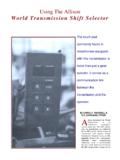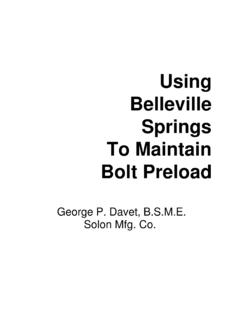Transcription of Software PLL Design Using C2000 MCUs Single …
1 Application Report SPRABT3A July 2013 Revised July 2017. Software Phase Locked Loop Design Using C2000 . Microcontrollers for Single Phase Grid Connected Inverter Manish Bhardwaj ABSTRACT. Grid connected applications require an accurate estimate of the grid angle to feed power synchronously to the grid. This is achieved Using a Software phase locked loop (PLL). This application report discusses different challenges in the Design of Software phase locked loops and presents a methodology to Design phase locked loops Using C2000 controllers for Single phase grid connection applications. Contents 1 Introduction .. 1. 2 PLL With Notch Filter .. 3.
2 3 Orthogonal Signal Generator PLL .. 14. 4 Solar Library and ControlSuite .. 24. 5 References .. 24. List of Figures 1 Phase Locked Loop Basic Structure .. 2. 2 Single Phase PLL With Notch Filter .. 3. 3 Bode Diagram .. 5. 4 PLL Response to Varying Grid Conditions .. 9. 5 Implemented SPLL at Steady State With Phase Jump and Scope Captures .. 13. 6 OSG Based Single Phase PLL .. 14. 7 Second Order Generalized Integrator for Orthogonal Signal 14. 8 Extraction of the Fifth Harmonic Using the SOGI .. 15. 9 PLL Response to Varying Grid Conditions .. 18. 10 Transient 23. Trademarks C2000 , ControlSuite are trademarks of Texas Instruments. MATLAB is a registered trademark of The MathWorks, Inc.
3 All other trademarks are the property of their respective owners. 1 Introduction The phase angle of the utility is a critical piece of information for the operation of power devices feeding power into the grid like PV inverters. A phase locked loop is a closed loop system in which an internal oscillator is controlled to keep the time and phase of an external periodical signal Using a feedback loop. The PLL is simply a servo system that controls the phase of its output signal such that the phase error between the output phase and the reference phase is minimum. The quality of the lock directly affects the performance of the control loop in grid tied applications.
4 As line notching, voltage unbalance, line dips, phase loss and frequency variations are common conditions faced by equipment interfacing with electric utility, the PLL needs to be able to reject these sources of error and maintain a clean phase lock to the grid voltage. SPRABT3A July 2013 Revised July 2017 Software Phase Locked Loop Design Using C2000 Microcontrollers for 1. Submit Documentation Feedback Single Phase Grid Connected Inverter Copyright 2013 2017, Texas Instruments Incorporated Introduction A functional diagram of a PLL is shown in Figure 1, which consists of a phase detect (PD), a loop filter (LPF), and a voltage controlled oscillator (VCO).
5 PD VCO. LPF. Measure Vgrid Vd out out Sin e v = vgrid sin( in ) Kd kp + ki Ko + 1/s cos o V'. Figure 1. Phase Locked Loop Basic Structure The measured grid voltage can be written in terms the grid frequency (wgrid) as follows: v = v grid sin(qin ) = v grid sin(w grid t + qgrid ) (1). Now, assuming VCO is generating sine waves close to the grid sinusoid, VCO output can be written as, v ' = cos(qout ) = cos(w PLLt + qPLL ) (2). The purpose of the phase detect block is to compare the input sine with the locked sine from the VCO and to generate an error signal proportional to the angle error. For this, the phase detect block multiplies the VCO output and the measured input value to get: Kd v grid vd = [sin((w grid - w PLL )t + (q grid - qPLL )) + sin((w grid + w PLL )t + (q grid + qPLL ))].
6 2 (3). From Equation 3, it is clear that the output of PD block has information of the locking error. However, the locking error information available from the PD is not linear, and has a component which is varying at twice the grid frequency. To use this locking error information to lock the PLL angle, twice the grid frequency component must be removed. For now, ignoring the twice of grid frequency component, the lock error is given as: Kd v grid vd = sin((w grid - w PLL )t + (q grid - qPLL )). 2 (4). For steady state operation, the wgrid - wPLL term can be ingored, for small values of theta sin( ) ~ . Hence, a linearized error is given as: v grid (q grid - qPLL ).
7 Err =. 2 (5). This error is the input to loop filter, which is nothing but a PI controller, that is used to reduce the locking error at steady state to zero. The small signal analysis is done Using network theory, where the feedback loop is broken to get the open loop transfer equation and then the closed-loop transfer function: Closed Loop TF = Open Loop TF / (1+ OpenLoopTF). Thus, for the linearized feedback the PLL transfer function can be written as follows: Closed loop Phase TF: kp v qout (s ) grid (k ps + T ). LF (s ) i Ho (s ) = = =. qin (s ) s + LF (s ) 2 kp s + v grid k ps + v grid Ti Closed loop error transfer function: V (s ) s s2.
8 Eo (s ) = d = 1 - Ho (s ) = =. qin (s ) s + LF (s ) kp s 2 + k ps +. Ti 2 Software Phase Locked Loop Design Using C2000 Microcontrollers for SPRABT3A July 2013 Revised July 2017. Single Phase Grid Connected Inverter Submit Documentation Feedback Copyright 2013 2017, Texas Instruments Incorporated PLL With Notch Filter Comparing the closed loop phase transfer function to a generic second order system transfer function, which is given as: 2zwns + wn2. H (s ) =. s 2 + 2zwns + wn2 (6). The natural frequency and the damping ration of the linearized PLL are given as: v grid K p wn =. Ti (7). (8). v gridTi K p z =. 4 (9). Note in the PLL, the PI serves dual purpose: To filter out high frequency that is at twice the frequency of the carrier and grid Control response of the PLL to step changes in the grid conditions, for example, phase leaps, magnitude swells, and so forth.
9 As the loop filter has low-pass filter characteristic, it can be used to filter out the high frequency component that was ignored earlier. If the carrier frequency/ frequency of the signal being locked is high, the low-pass characteristics of the PI are good enough to cancel the twice of carrier frequency component. However, for grid connected applications as the grid frequency is very low (50Hz-60Hz), the roll off provided by the PI is not satisfactory enough and introduces a high frequency element into the loop filter output, which affects the performance of the PLL. From the discussion above, it is clear that the LPF characteristic of the PI controller cannot be used to eliminate the twice to grid frequency component from the phase detect output in case of grid connected applications.
10 Hence, alternative methods must be used that linearize the PD block. In this application report, two PLL methods that linearize the PD output, are illustrated: One uses a notch filter to filter out twice the grid frequency component from the PD output The other uses an orthogonal signal generation method to use stationary reference frame PLL. technique in Single phase PLL. 2 PLL With Notch Filter A notch filter can be used at the output of the phase detect block, which attenuates twice the grid frequency component very well. An adaptive notch filter can also be used to selectively notch the exact frequency in case there are variations in the grid frequency.

















